Having observed the fringing reefs found near my home on Mactan island since 2004,
I have become much more aware of not only how the various habitats work
in conjunction with each other, but also what threatens the balance
that each of them brings to the reef equation. By taking apart that
equation, I hope to show how we can recreate the reef's solutions
and apply them to reef aquariums, thus creating a more
realistic, and functional coral reef within the
glass boxes that we like to call our reef aquariums. This series
of articles will examine a Philippine fringing reef's habitats and
how we can apply each of those habitats to our reef aquarium systems
with the
intention of creating a functional ecosystem that
provides multiple habitats, each with their own unique populations
that in combination will provide the means to further the
hobby towards the meaning of the word "reef".
Part One: Land meets Ocean
What
is a fringing reef? They are those reefs that develop
in shallow waters along
the coast of tropical islands or continents. Fringing reefs are
generally narrow platforms a short distance from shore and do not
contain substantial lagoons. Given suitable substrates and no
algal competition, the corals would grow right up to the shoreline. But
with the constant influx of sediments, having those sediments moved
about through tidal and wave actions, and with high dissolved nutrient
levels near shore, corals are restricted to those areas that
lack sediment and nutrient-fueled algae.
What is a reef aquarium? Note that I did not ask what is a
coral
reef aquarium. I purposely left out the word coral simply because
a reef is so much more than just a few coral species growing on top of
some rocks. With the vast diversity of life found on a reef,
we should strive to obtain and maintain as much of that diversity as
possible in order to be able to use the word "reef" when describing our
aquariums. In order to do so, we must provide not only the habitat for
the corals to thrive in, we must also provide the various other
habitats that, in turn, make a fringing coral reef possible. It is my
hope that through this series of articles you and I will both get a
sense of the much bigger picture that the word "reef" should invoke.
So what do
fringing reefs have in common with our reef aquariums? As it turns out,
a great deal with the
answer found in one word; nutrients. Just as our aquariums
struggle with the daily input of nutrients, so do most of the fringing
reefs of
the world. With shore-based nutrients and sediment run-off into the
oceans, fringing reefs have developed a number of habitats that
in combination allows coral reef development to exist in
areas that normally would not be favorable to coral growth. It is
notable that I describe fringing reefs in a current historical context
since many of the inputs to fringing reefs are anthropogenic in origin
and have not always impacted coastal areas as they do today.

We will, of course, not be able to contain the various fringing reef
habitats all in one aquarium for a number of reasons. Space for the
habitats is the main issue, but we also have to ensure that each
habitat is given functional separation from the inhabitants of the others. Keeping
predators, prey and grazers apart from each other will ensure a greater
diversity is possible. Such refuge can only be obtained by having a
number of aquariums, each being their own habitat, while able to share
the entire system's water volume thus creating a functional ecosystem.
With ever
increasing human populations, the land is subjected to more and more
development that is putting increasingly greater amounts of terrestrial based
nutrients and sediments into the ocean (Gorgula 2004), especially when heavy rains wash the
land and flush it into the oceans. The first line of defense that the
coral reefs have against such pollutants can be found right at the
shoreline.
Filamentous algae that form turf mats on near shore substrates.
All
along the coast, from the shore line to approximately
fifty yards into the shallow ocean, a great deal of filamentous algae can
be found. These fast growing algae form both a turf mat on
the
shoreline boulders as well as suspended strands and clumps in slightly deeper
water. The shoreline turfs are comprised of numerous
species of tightly packed erect filaments that are generally 3 to
5-mm high and accumulate a great deal of sediments. These algal turfs
are permanent occupants on the available nearshore substrates while
the suspended mats tend to be transient in nature with their appearance
being dependent upon the availability of nutrient loaded run off from
terrestrial sources.
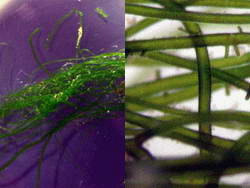
The suspended
mats appear to be generally monospecific. After periods of heavy rainfall, the
speed at which these algae grow can be quite rapid, indicating the amounts of nutrients
that are being washed into the ocean as well as suggesting that
such algae species respond to and utilize those nutrients for rapid growth.
In
a recent study (McClanahan 2007) it was shown that the turf algae were
responsible for the greatest amount of nitrogen and phosphorous uptake
when subjected to field tests. In the study, the growth of algae
on coral skeletons were examined while subjected to four treatments; an
untreated control, a pure phosphate fertilizer, a pure nitrogen
fertilizer, and an equal mix of the two fertilizers. Turf algae cover
was the only algae to respond significantly to
fertilization. The encrusting corallines and frondose algal cover
showed either a marked decline or complete loss when subjected to
fertilization. Algae turf cover was three times
higher in treatments with added nitrogen when compared with the pure
phosphorus treatment, making the turf algae limited by either too much
of one, or not enough of the other.
Since nitrogen
and phosphorous compounds are the most abundant nutrients within a
typical reef aquarium, it would be wise to understand
the basics of how varying levels of those compounds can either limit or
encourage the growth and diversity of algae and cyanobacteria.
A high phosphate and low nitrogen content appears to enhance
the abundance of nitrogen-fixing cyanobacteria while at the same time
reducing the diversity of algae cover, most notably the large (macro)
frondose algae species.
High nitrogen and low
phosphate is also effective in influencing algae species
composition, increasing the cover of various small turf-forming
green algae and cyanobacteria. In the study, high nitrogen did not
increase the abundance of
other algae groups. Within the hobby it is generally accepted that
phosphates will fuel the rapid growth of cyanobacteria. This is
supported in the study,
but not in the sense that the cyanobacteria are acting on phosphate
levels alone. With phosphates being a limiting factor on the macro
algae, such limitation would make more nitrogen compounds available for
the cyanobacteria resulting in decreased algae diversity and increased
cyanobacteria. Furthermore, Thacker has shown in several publications
(Thacker et al.2001) the strongest negative correlation for common mat-forming
cyanobacteria (i.e.
Lyngbya spp.) to be water flow and not a lack of nutrients.
Under a normal feeding and maintenance
regimen of a typical reef aquarium, it is likely there will
be somewhat of a balance between phosphorous and nitrogen
compounds since most organisms used for food contain relatively
balanced C:P ratios. The level of the balanced nutrient load will still
be a
factor in what species of algae will be favored in a given aquarium. A
properly fed reef aquarium (Borneman 2002), which is one that provides
the daily nutritional requirements in the correct quantity, quality and
particle size for all of the aquariums inhabitants will normally have a
slightly higher
balanced level than found near coral reefs due to the constraints of an
enclosed, relatively minute volume of water that aquariums are.
The use of filamentous
algae with their apparent ability to quickly reduce excessive
phosphates and nitrates will keep the nutrient levels low enough to
where the larger and less nutrient-requiring macro algae species, that
are
usually kept within an algae refugium or sump section, can thrive.
These species further reduce nutrients while adding
diversity, all to the well-being of the
entire aquarium system. Should the nutrient levels rise rapidly, the
macroalgae, instead of growing faster will be limited while the turf
algae species will respond to the increase and quickly bring
nutrient
levels back into reef tolerances, while at the same time denying
cyanobacteria the phosphate-rich conditions that favor it from becoming
dominant.
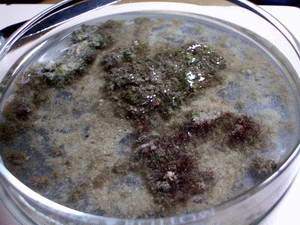
At
first glance the shoreline turf algae does not appear to be much to
look at, but upon closer examination with a microscope I was quite
surprised by the diversity of life forms that use these algae mats as a
habitat in which to live.
A
single square inch scraping yielded many microscopic animals that I
normally associate with macroalgae covered rocks in deeper water. Note the amount of sediment held within a small sampling.

Within the above sample, I counted at least eight different
species of filamentous algae, and the apparent monospecificity by
appearance is clearly deceptive. They are all intertwined creating a
living net
that captures and holds both abiotic sediments and detritus. Not only
do these
living nets give the algae more substrate on which to anchor and expand
their growth, they in turn provide both habitat and food for a
multitude of microscopic animals, which are then preyed upon by
microscopic predators. A microcosm that has a complete food chain
starting with the filamentous algae being sought after by a number of
herbivores who then become food for slightly larger predators, all
performing the much needed nutrient extraction and production from the
surrounding
waters.
Below are just a few examples of the many life forms found within the
sample, which also included numerous protozoans and other animals too
small for me to photograph properly.
In
the 1970s, Dr. Walter Adey, Curator of coralline algae and Director of
the Marine Systems Laboratory at the Smithsonian Institution in
Washington DC (USA), was studying corals and soon realized that
nutrient levels within his aquariums had to be managed. Dr. Adey
looked to natural processes for the solution which led to the
development of a more suitable habitat that had most of the
natural reef components necessary to support a tropical coral reef.
By providing for the same conditions as are found on a natural reef
shoreline, Dr. Adey surmised that it could be possible to use filamentous
algae as a filter to remove nutrients from an enclosed aquarium system.
By simply incorporating plastic mesh screens into a surge device, Dr.
Adey was able to recreate the conditions that favored the filament
algae species and thus the Algae Turf Scrubber® was born.
Within all ecosystems, photosynthesis by plants, bacteria and algae
forms the basis of all food chains with some exceptions; perhaps most notably those of deep ocean
hydrothermal vents. Algae, like other plants, must absorb nitrogen and
other nutrients for growth and reproduction. The development of
the Algae Turf Scrubber® simply simulates the processes that occur in
nature on any shoreline; a device that provides sufficient water movement over
semi-submerged substrates and high light intensity. In these areas of
turbulent mixing, a zone of short, dense algae will develop.
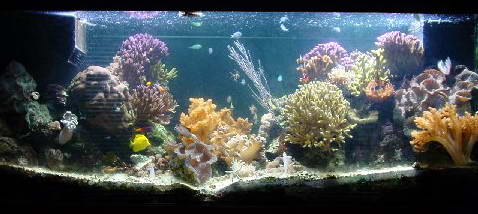
Photo Courtesy by Morgan Lidster of Inland Aquatics The above photo illustrates a 225 gallon custom reef system after about 30 months with
ATScrubbing as the only means of nutrient export. The ATShuttle Model 250
(algal screen measures 9.5" x 24") is scraped once a week. BioTrace and Restore
(B-Ionic analog) are added weekly and frozen foods are fed weekly. All other
maintenance is handled by the ATS and the automatic feeder, with the exception
of the two 24 gallon water changes during that time frame.
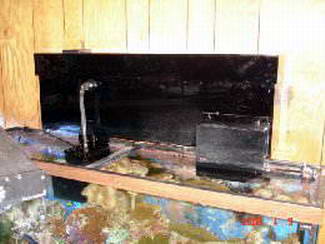
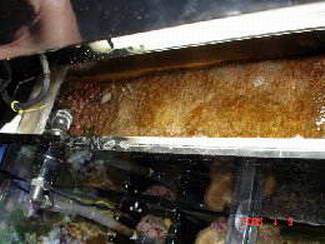
Mini (Hang
On) ATScrubber on 75 gallon reef View of the screen on the Mini ATScrubber
Inland Aquatics has been so kind as to provide the photographs of
various ATScrubber models, all of which are available for purchase for
those of us not inclined towards do it yourself projects. For
more information please contact Morgan at
InlandAquatics@aol.com 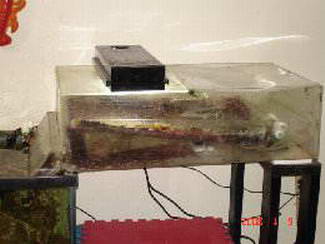
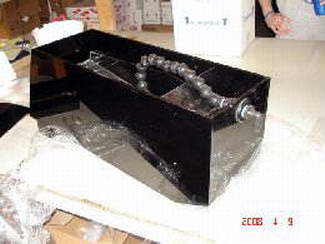
A 325 gallon ATS prototype display
ATScrubber
model 225
The
Algae Turf Scrubber® has been around now for quite a number of years and
at one time, was used by many hobbyists, yet lately it seems
to
have fallen by the way side within the hobby and never really became widely utilized. With a
great many aquariums that combat filamentous algae growth, it is
understandable that such algae species are looked upon with scorn and
not thought of as being able to work for our aquariums instead of
against them. The only problem with having such algae species is
simply a matter of location. Just as the reefs in the ocean cannot have
such turf algae growth, neither can our coral aquariums as the turfs would quickly
smother our corals. This is not to say that we cannot use
such algae, but we have to force limitations upon it.
Having noticed in my own aquarium that such filamentous algae only grew within the interiors
of my overflow boxes, I soon realized that I had unintentionally forced
the algae to seek its own refuge. Not only were the overflow boxes
providing the high water flow and light intensity that turf algae require, but it
was also providing a safe haven from the larger algae grazers of my system; most notably the ringed cowry (
Cypraea annulus) and a brown tang (
Zebrasoma scopas).
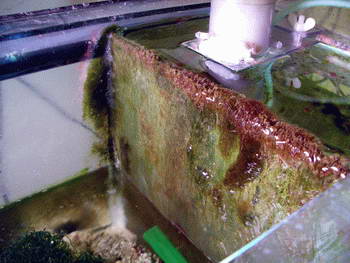
Not
wanting to miss out on the nutrient uptake potential of these fast
growing algae species as I see in the nearshore areas of my local reef,
and not having the space to install a dedicated turf algae
habitat, I allowed the last baffle of my sump to provide the same
conditions as found in my overflow boxes. Simply lowering the water
level of the sump's last compartment to expose more glass to the
"waterfall" effect and providing sufficient light intensity soon had a
simple turf algae scrubber in action.
Once a week I simply take a
single edged razor blade and clean alternating stripes down the length
of the glass, leaving a razor blade's width of untouched algae between
the cleaned stripes so that by the next week, it will have grown back
onto the cleaned areas, giving me another crop to harvest the following week. This
can, of course, be expanded to include more glass panels to get the same
"waterfall" effect on multiple panes as part of a sump or as a
dedicated turf algae habitat, which has many possible designs, one of which is bound to serve your needs.
As of May 2009 my main display aquarium has been running as a single
tank system with one important feature installed. A compartment
section that provides the surface area for an ATS as well as the
important surface skimming as the water overflows into the compartment.
For those of you with limited space this is by far one of the
best methods I have ever employed in maintaining proper dissolved
nutrient levels while at the same time providing yet another habitat
that creates a great deal of zooplankton.
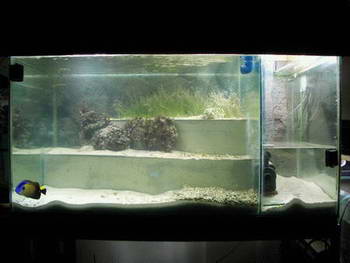
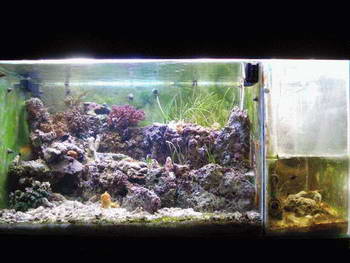
By placing a matting material onto the glass, it gives the filamentous
algae a rougher surface in which to hang onto and speeds it growth,
which in turn speeds the nutrient reduction. Once a week I simply
scape off the algae and discard, thus exporting a good amount of
nutrients along with it. I chose to use a side compartment as I
do not have easy access to the back of the aquarium, but for those that
do, you could run such a compartment along the back of the aquarium
making it virtualy invisible. Proper bracing of the compartment's
glass is very important.
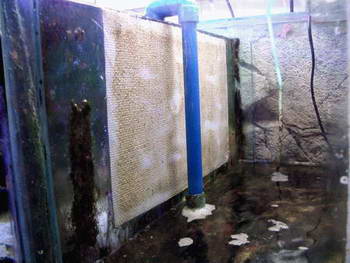
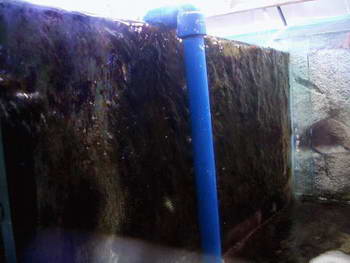
Generally, most of us only think in terms of
either how to be rid of algae, or how it can be used to remove nutrients
from our aquarium's water. What is often over looked is that even the
filamentous algae provide yet another habitat within our aquarium's
system
and is home to a great many different animals. I was pleasantly
surprised to discover that the wild algae mats and my aquarium mats are
almost indistinguishable, both containing several filamentous algae
species and nearly the same microscopic life forms
which contribute to the
diversity and functionality of a natural reef and my reef aquarium.

Within this one sampling of filament algae taken from my sump's
mini turf scrubber, I was able to find a great many species of
microscopic life forms. Some we are all familiar with and some were
quite a surprise.
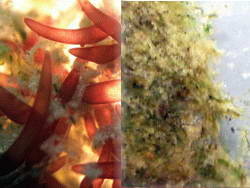
There appears to be two or more species of filamentous algae
taking advantage of the conditions
that I provided for them. All of which trap a good amount of detritus
which in turn feeds the microscopic life found living amongst the red
and green branches of this miniature aquatic forest. These
algae species are often known as "nuisance algae" and "undesirable"
which could be said of any algae if they are able to grow unchecked
either out on the coral reef or within our coral display aquariums
where such algae can easily outcompete the corals. Such algae is
however highly desirable as part of the reef aquarium's nutrient exporting and live food production mechanisms.
When found to be growing where they are not wanted, many hobbyists
will wage an all out war upon these algae species determined to
eradicate
them entirely through a great many methods ranging from nutrient
starvation, turning off lights to the aquarium for extended periods of
time, adjusting basic water parameters to unnatural levels, or adding
subtropical
herbivorous animals that will consume the algae while they slowly die
from being in
tropical temperatures. The eradication method most often suggested is
to reduce nutrient levels to starve out the algae. What is not often
thought of is that by starving out the algae, you are in effect also
starving your corals and fish in a direct and an indirect manner by
denying them a
ready supply of live food that such a habitat can produce, a
habitat that in itself is reducing nutrient levels
at the same time they are providing your larger species with nutrition.
Below are but a few examples of the life forms that were found in a
small sampling of filament algae.




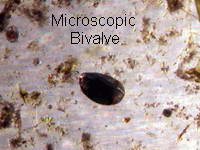

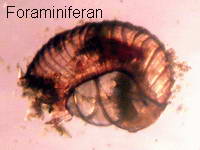
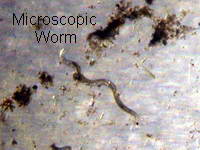
The most abundant of the infauna appears to be microscopic worms that
feed upon the detritus that the algae traps out of the water, with
copepods and amphipods being the next most numerous members of the
algae infauna. Other infauna does not appear to be feeding upon either
the algae or the detritus that it traps but instead simply use the
algae as a substrate in which they gain shelter from predators while they gather
passing food particles such as phytoplankton and bacteria.
Having
such an abundance of microscopic animals not only provides nutrient
processing but they also contribute to the feeding of the larger
members of our aquariums, thus reducing the need to add additional
nutrients in the form of prepared foods while providing highly
nutritious live food in the form of both adult infauna and their spawn.
Additionally, such live food is of the correct size for many of the
coral species we wish to maintain.
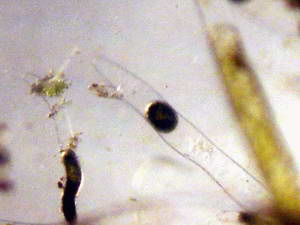
The remains of an algae filament after having had its cells consumed.
The amphipod species living within the filamentous algae feeds
directly upon the algae by piercing a filament and withdrawing the
algae cells as it feeds, leaving behind the transparent algae membrane.
It has been argued (Hay et al. 1987) that amphipods could be
ecologically similar to terrestrial insects by having evolved a
tolerance to secondary compounds that deter other herbivores, thus
allowing them to feed upon algae species that other herbivores are
unable to eat while gaining protection from predators within the confines of the
algae. Such grazing, while evident in the algae samples I have
examined, is not enough to control the algae or limit its spread. It
does, however, appear that such grazing stimulates algae growth as the
amphipods reduce the mature filaments exposing the vigorous pioneer
stages of the algal population.
Aside from gaining a natural method of reducing nutrients and providing
more biodiversity, there are a number of other benefits one can realize
from employing a "pest algae" If run on an alternate light cycle, the
photosynthesis that will take place during the night will keep the
aquarium system's oxygen level and pH much more stabilized during the
night's normally lowered oxygen and pH levels.
Many other
hobbyists have noted other "side" benefits of using filamentous
algae within their systems, most notably an overall healthy environment
that others have used as a "hospital" tank to allow weakened, stressed
fish and corals to recover. To me, that is a very obvious indication
that naturally run aquariums do provide a much better environment for
our pets than other traditional methods that work so hard at removing
any and all nutrients, particulate matter, algae, and of course,
any microscopic animals that could have been feeding the aquarium's
inhabitants.
Providing the filamentous algae a place within your
aquarium system will also reduce or eliminate the need to run a protein skimmer or
any other mechanical filtration. In fact I would discourage the use of
such equipment as they are intended to remove the very benefits of what
the algae habitat is providing. It would make no sense to have numerous
microscopic animals being produced only to filter and eliminate them, thus
denying your pets a good source of live nutrition.
Of course now one must ask how such algae can be kept restricted to one
specific area and not allowed to over grow the coral display aquarium.
The answer is simply to provide enough suitable grazers as
mentioned previously. A brown scopas tang along with any number of
herbivore snails will keep filamentous turfs as well as most other
palatable algae species
in check. The turf algae species shown above seems to restrict itself
by
requiring high rates of water flow while growing within the boundary
between water and air, just as it does on turbulent shorelines and in
my overflow boxes. If enough space is given, it will also
nutrient-limit itself.
I am of the opinion that if this hobby is
going to progress past simply keeping corals alive and continue to use the
words "reef" and "aquarium" within the same sentence, then we are going
to have to learn of the reef's ecosystems and apply them in our
attempts to contain a reef within our homes. Please take the time and
effort to look beyond your coral specimens and wonder at the diversity and
beauty of function that in nature, takes care of these corals.
Related Reading : A Philippine Fringing Reef & The Reef Aquarium Part Two A Philippine Fringing Reef & The Reef Aquarium Part Three A Philippine Fringing Reef & The Reef Aquarium Part Four
An Online Philippine Reef Tour The Reef Aquarium Clean Up Crew Acknowledgments :
I would like to thank my wife Linda for her loving
support and understanding of my interests in all things marine. A
special thanks also goes out to Eric Borneman for his generosity in
providing assistance with this article and in helping me to make sense
of tropical reefs. To Dr. Ron Shimek and Leslie Harris, thank you for
the many identifications made as well as teaching me a great deal about
marine biology.
References: Adey W. (1982), The Microcosm: A New Tool for Reef Research. Coral Reefs (1983) 1:193 201
Bell S. (1991), Amphipods as Insect Equivalents? An Alternative View Ecology, Vol. 72, No. 1 (Feb., 1991), pp.
350-354
Borneman E. (2002), Reef Food, http://reefkeeping.com/issues/2002-07/eb/index.php
Gorgula S. et al. (2004), Expansive covers of turf-forming
algae on human-dominated coast: the relative effects of increasing
nutrient and sediment loads. Marine Biology (2004) 145: 613–619
McClanahan,
T.R. et al. (2007), Effect of nitrogen, phosphorous, and their interaction on
coral reef algae succession, Mar. Pollut. Bull. (2007),
doi:10.1016/j.marpolbul.2007.09.023
Thacker,
R.W., Ginsburg, D.W., Paul, V.J., 2001. Effects of herbivore exclusion
and nutrient enrichment on coral reef macroalgae and cyanobacteria.
Coral Reefs 19, 318–329.
© 2009 All Rights Reserved
All content including photographs is copyright protected and may not be
used or reproduced without written permission of the authors.



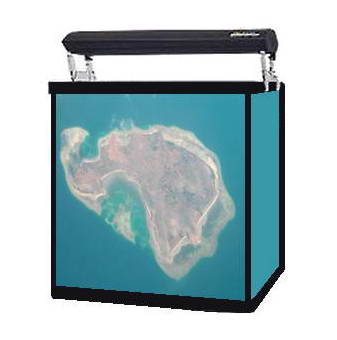
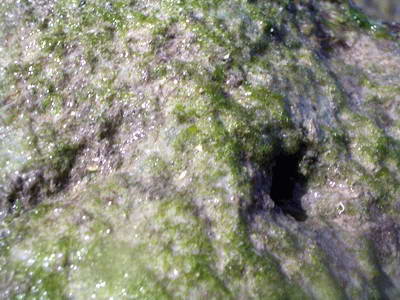
 The suspended
mats appear to be generally monospecific. After periods of heavy rainfall, the
speed at which these algae grow can be quite rapid, indicating the amounts of nutrients
that are being washed into the ocean as well as suggesting that
such algae species respond to and utilize those nutrients for rapid growth.
The suspended
mats appear to be generally monospecific. After periods of heavy rainfall, the
speed at which these algae grow can be quite rapid, indicating the amounts of nutrients
that are being washed into the ocean as well as suggesting that
such algae species respond to and utilize those nutrients for rapid growth. At
first glance the shoreline turf algae does not appear to be much to
look at, but upon closer examination with a microscope I was quite
surprised by the diversity of life forms that use these algae mats as a
habitat in which to live. A
single square inch scraping yielded many microscopic animals that I
normally associate with macroalgae covered rocks in deeper water. Note the amount of sediment held within a small sampling.
At
first glance the shoreline turf algae does not appear to be much to
look at, but upon closer examination with a microscope I was quite
surprised by the diversity of life forms that use these algae mats as a
habitat in which to live. A
single square inch scraping yielded many microscopic animals that I
normally associate with macroalgae covered rocks in deeper water. Note the amount of sediment held within a small sampling. Within the above sample, I counted at least eight different
species of filamentous algae, and the apparent monospecificity by
appearance is clearly deceptive. They are all intertwined creating a
living net
that captures and holds both abiotic sediments and detritus. Not only
do these
living nets give the algae more substrate on which to anchor and expand
their growth, they in turn provide both habitat and food for a
multitude of microscopic animals, which are then preyed upon by
microscopic predators. A microcosm that has a complete food chain
starting with the filamentous algae being sought after by a number of
herbivores who then become food for slightly larger predators, all
performing the much needed nutrient extraction and production from the
surrounding
waters.
Within the above sample, I counted at least eight different
species of filamentous algae, and the apparent monospecificity by
appearance is clearly deceptive. They are all intertwined creating a
living net
that captures and holds both abiotic sediments and detritus. Not only
do these
living nets give the algae more substrate on which to anchor and expand
their growth, they in turn provide both habitat and food for a
multitude of microscopic animals, which are then preyed upon by
microscopic predators. A microcosm that has a complete food chain
starting with the filamentous algae being sought after by a number of
herbivores who then become food for slightly larger predators, all
performing the much needed nutrient extraction and production from the
surrounding
waters. 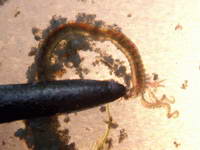
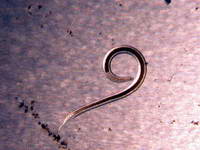

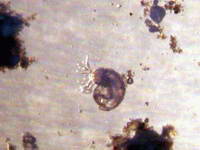









 Not
wanting to miss out on the nutrient uptake potential of these fast
growing algae species as I see in the nearshore areas of my local reef,
and not having the space to install a dedicated turf algae
habitat, I allowed the last baffle of my sump to provide the same
conditions as found in my overflow boxes. Simply lowering the water
level of the sump's last compartment to expose more glass to the
"waterfall" effect and providing sufficient light intensity soon had a
simple turf algae scrubber in action.
Not
wanting to miss out on the nutrient uptake potential of these fast
growing algae species as I see in the nearshore areas of my local reef,
and not having the space to install a dedicated turf algae
habitat, I allowed the last baffle of my sump to provide the same
conditions as found in my overflow boxes. Simply lowering the water
level of the sump's last compartment to expose more glass to the
"waterfall" effect and providing sufficient light intensity soon had a
simple turf algae scrubber in action.



 Within this one sampling of filament algae taken from my sump's
mini turf scrubber, I was able to find a great many species of
microscopic life forms. Some we are all familiar with and some were
quite a surprise.
Within this one sampling of filament algae taken from my sump's
mini turf scrubber, I was able to find a great many species of
microscopic life forms. Some we are all familiar with and some were
quite a surprise.  There appears to be two or more species of filamentous algae
taking advantage of the conditions
that I provided for them. All of which trap a good amount of detritus
which in turn feeds the microscopic life found living amongst the red
and green branches of this miniature aquatic forest. These
algae species are often known as "nuisance algae" and "undesirable"
which could be said of any algae if they are able to grow unchecked
either out on the coral reef or within our coral display aquariums
where such algae can easily outcompete the corals. Such algae is
however highly desirable as part of the reef aquarium's nutrient exporting and live food production mechanisms.
There appears to be two or more species of filamentous algae
taking advantage of the conditions
that I provided for them. All of which trap a good amount of detritus
which in turn feeds the microscopic life found living amongst the red
and green branches of this miniature aquatic forest. These
algae species are often known as "nuisance algae" and "undesirable"
which could be said of any algae if they are able to grow unchecked
either out on the coral reef or within our coral display aquariums
where such algae can easily outcompete the corals. Such algae is
however highly desirable as part of the reef aquarium's nutrient exporting and live food production mechanisms.








